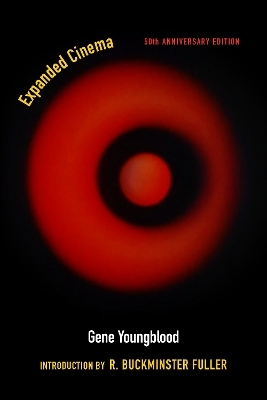
Expanded Cinema
Fordham University Press (Verlag)
978-0-8232-8741-3 (ISBN)
First published in 1970, Gene Youngblood’s influential Expanded Cinema was the first serious treatment of video, computers, and holography as cinematic technologies. Long considered the bible for media artists, Youngblood’s insider account of 1960s counterculture and the birth of cybernetics remains a mainstay reference in today’s hypermediated digital world. This fiftieth anniversary edition includes a new Introduction by the author that offers conceptual tools for understanding the sociocultural and sociopolitical realities of our present world.
A unique eyewitness account of burgeoning experimental film and the birth of video art in the late 1960s, this far- ranging study traces the evolution of cinematic language to the end of fiction, drama, and realism. Vast in scope, its prescient formulations include “the paleocybernetic age,” “intermedia,” the “artist as design scientist,” the “artist as ecologist,” “synaesthetics and kinesthetics,” and “the technosphere: man/machine symbiosis.” Outstanding works are analyzed in detail. Methods of production are meticulously described, including interviews with artists and technologists of the period, such as Nam June Paik, Jordan Belson, Andy Warhol, Stan Brakhage, Carolee Schneemann, Stan VanDerBeek, Les Levine, and Frank Gillette. An inspiring Introduction by the celebrated polymath and designer R. Buckminster Fuller—a perfectly cut gem of countercultural thinking in itself—places Youngblood’s radical observations in comprehensive perspective.
Providing an unparalleled historical documentation, Expanded Cinema clarifies a chapter of countercultural history that is still not fully represented in the arthistorical record half a century later. The book will also inspire the current generation of artists working in ever-newer expansions of the cinematic environment and will prove invaluable to all who are concerned with the technologies that are reshaping the nature of human communication.
Gene Youngblood (Author) Gene Youngblood is a well-known theorist of electronic media arts and a respected scholar in the history and theory of experimental film and video art. He has split his career between teaching and journalism and is also widely known as a pioneering voice in the Media Democracy movement. R. Buckminster Fuller (Introducer) R. Buckminster Fuller was an architect, designer, inventor, social theorist, and the author of more than thirty books, including the legendary Operating Manual for Spaceship Earth.
List of Illustrations | ix
Introduction to the Fiftieth Anniversary Edition | xiii
Introduction by R. Buckminster Fuller | 15
Inexorable Evolution and Human Ecology by R. Buckminster Fuller | 37
Preface | 41
Part One: The Audience and the Myth of Entertainment | 45
Radical Evolution and Future Shock in the Paleocybernetic Era | 50
The Intermedia Network as Nature | 54
Popular Culture and the Noosphere | 57
Art, Entertainment, Entropy | 59
Retrospective Man and the Human Condition | 66
The Artist as Design Scientist | 70
Part Two: Synaesthetic Cinema: The End of Drama | 75
Global Closed Circuit: The Earth as Software | 78
Synaesthetic Synthesis: Simultaneous Perception of Harmonic Opposites | 81
Syncretism and Metamorphosis: Montage as Collage | 84
Evocation and Exposition: Toward Oceanic Consciousness | 92
Synaesthetics as Kinaesthetics: The Way of All Experience | 97
Mythipoeiai: The End of Fiction | 106
Synaesthetics and Synergy | 109
Synaesthetic Cinema and Polymorphous Eroticism | 112
Synaesthetic Cinema and Extra-Objective Reality | 122
Image-Exchange and the Post-Mass Audience Age | 128
Part Three: Toward Cosmic Consciousness | 135
2001: The New Nostalgia | 139
The Stargate Corridor | 151
The Cosmic Cinema of Jordan Belson | 157
Part Four: Cybernetic Cinema and Computer Films | 179
The Technosphere: Man/Machine Symbiosis | 180
The Human Bio-Computer and His Electronic Brainchild | 183
Hardware and Software | 185
The Aesthetic Machine | 189
Cybernetic Cinema | 194
Computer Films | 207
Part Five: Television as a Creative Medium | 257
The Videosphere | 260
Cathode-Ray Tube Videotronics | 265
Synaesthetic Videotapes | 281
Videographic Cinema | 317
Closed-Circuit Television and Teledynamic Environments | 337
Part Six: Intermedia | 345
The Artist as Ecologist | 346
World Expositions and Nonordinary Reality | 352
Cerebrum: Intermedia and the Human Sensorium | 359
Intermedia Theatre | 365
Multiple-Projection Environments | 387
Part Seven: Holographic Cinema: A New World | 399
Wave-Front Reconstruction: Lensless Photography | 400
Dr. Alex Jacobson: Holography in Motion | 404
Limitations of Holographic Cinema | 407
Projecting Holographic Movies | 411
The Kinoform: Computer-Generated Holographic Movies | 414
Technoanarchy: The Open Empire | 415
Selected Bibliography | 421
Index | 427
| Erscheinungsdatum | 18.02.2020 |
|---|---|
| Reihe/Serie | Meaning Systems |
| Einführung | R. Buckminster Fuller |
| Zusatzinfo | 60 color illustrations and 284 b/w illustrations. |
| Verlagsort | New York |
| Sprache | englisch |
| Maße | 140 x 210 mm |
| Themenwelt | Kunst / Musik / Theater ► Film / TV |
| Mathematik / Informatik ► Informatik ► Theorie / Studium | |
| Sozialwissenschaften ► Kommunikation / Medien ► Medienwissenschaft | |
| ISBN-10 | 0-8232-8741-6 / 0823287416 |
| ISBN-13 | 978-0-8232-8741-3 / 9780823287413 |
| Zustand | Neuware |
| Haben Sie eine Frage zum Produkt? |
aus dem Bereich


